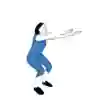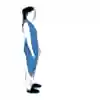Mohammed Umar never had the chance to turn out for a football team when he was in school. But that never stopped him from enjoying the beautiful game with his friends.
Those early days shaped Umar’s style of play. Most times, football was either played in tiny spaces in the courtyard of his home in Mumbai or on a ground packed with other kids during recess at school. As a result, while he did play football for his college, it was futsal that had his interest and what he enjoyed most.
“It’s all about quick decision-making – a trick or a pass, executed in a flash and it’s over. Besides, you can make as many substitutions as you want, replacing all five players with another set that has been trained to follow a different strategy. Futsal is more like a game of chess,” Umar says.
By 2017, he had made his debut in the Premier Futsal League, turning out against the likes of Ronaldinho, Paul Scholes and Ryan Giggs. Though the league is now defunct, Umar continues to play domestic and international tournaments, besides mentoring young footballers while donning the coach’s hat.
Improvisation has been key to the routine Umar follows today. Back in the day, most of the training that he was exposed to involved working on specific skills such as passing or shooting. Over time, he realised that the drills were not only monotonous but often resulted in strained muscles.
These days, he’s adapted to a workout which involves microcycles that last between four to eight weeks, wherein he targets specific, short-term goals that help his game on the pitch.
For a footballer, nothing is more important than having strong legs. So Umar highlights exercises that can help upcoming footballers develop strength, endurance and power in their legs.
Squats
Push your hips back and go down while extending your hands in front. Push your chest out and keep your back straight. It is important to ensure that your knees do not cross the toes. Now return to the starting position. Whether it is a weighted or a non-weighted squat, you must get into the habit of engaging the core muscles.
Lunges
Stand with your feet slightly apart. Step forward with your right foot and drop until your left knee is parallel to the ground. Your left knee should be in line with your shoulders and hips. Ensure that your front (right) knee doesn’t go beyond the toes. Now return to the starting position and repeat the exercise with the left knee forward.
Squats and lunges are compound movements, so they work on more than one muscle group and multiple joints.
Bulgarian split squats

1 min
Bulgarian split squats
An athlete performs the Bulgarian split squat in a living room of their home.
For this exercise, you will need a stable elevated platform placed just behind you. Place your left foot on the platform and get into a comfortable position. Now bend your hips and right knee until it forms an almost 90-degree angle. Return to the starting position and switch legs. The platform you use could be a bench, stairs, or anything else; ideally start with something of a lesser height and try a couple of reps to see if you are comfortable. As in case of a normal squat, ensure that your knee doesn’t cross the toe.
Glute bridges
Lie down on your back with your knees bent. Keep your hands by your side, make sure your ankles are exactly under your knees and the heels close to your butt. Then raise your hips as high as possible. While going up, ensure that you exhale and consciously contract the abdominal muscles. In particular this exercise works on the glutes but also impacts the hamstring, quads and calves.
Tuck jumps
Stand with your feet slightly apart, a little less than the width of the shoulders. Go down to a quarter squat position while keeping your back straight and then burst into an upward jump while folding your knees toward your chest. Land softly and return to the starting position.
Broad jumps
Stand with your feet shoulder-width apart and your arms raised. Push the arms behind you, bend your hips and your knees. Now swing your arms forward to generate momentum and in one quick movement leap forward, extending your body as much as possible while in the air. Land on both feet with your hands by your side.
The idea is to go as high as possible while also leaping forward as much as possible; but you should be comfortable at all times and land softly so there is no stress on your knees or ankles.
Leg hops
These are basic hops – think hopscotch that we played as kids – that can have multiple variations. The idea to jump high and far while landing as softly as possible. Hop in different directions to give yourself a bigger challenge. You can also use short jumps and add it to a ladder routine or a cone drill. The routine can be varied by using single leg hops as well as double leg hops.
Airplanes
The starting position is to have your feet together and raised by your side. With your right foot planted firmly, extend your left leg backwards while bending at the hips so your chest drops in front of you. At full extension, your chest and left leg should be parallel to the floor so your body forms a ‘T’. Return to the starting position and repeat by alternating the standing leg.
Single-leg deadlift
Attempt the single-leg deadlift only once you are perfectly comfortable with airplanes. Stand with your feet together and arms by your side with dumbbells in each hand. Extend your left leg backwards, bend at the hips and drop your chest. At full extension your left leg and chest should be parallel to the floor so your body forms a ‘T’. Your arms should be hanging straight down with the dumbbells close to the floor. Return to the starting position and repeat with the other leg.










